Tlahuica Ruins Near Cuernavaca
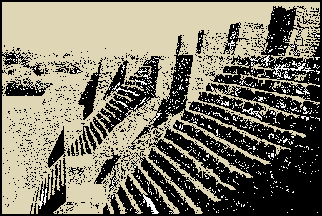 By Dr. Michael E. Smith,
Professor of Anthropology, University at Albany (State University of
New York)
By Dr. Michael E. Smith,
Professor of Anthropology, University at Albany (State University of
New York)
VERSION EN ESPANOL: TOQUE AQUI!
This page describes some of the
major archaeological ruins of the Tlahuica culture. These are located
in the Mexican state of Morelos, in and around the modern city of
Cuernavaca. The focus is on major excavated sites where architecture
has been restored for viewing today.
 Aztec culture was composed of many distinct ethnic groups that occupied
the central Mexican highlands in the centuries before the Spanish
conquest of 1521. The Tlahuica were the Aztec group living in what is
now the state of Morelos. Archaeologically, the Tlahuica culture dates
to the final centuries before the arrival of Spanish conquerors in
1521. The Tlahuica peoples migrated into Morelos in the Early Aztec
period (AD 1100-1350), also known as the Middle Postclassic period in
Mesoamerica. The Tlahuica expanded their numbers and influence in the
Late Aztec period (AD 1350-1521), also known as the Late Postclassic
period. Because Tlahuica culture was one variant of the more inclusive
Aztec culture of central Mexico, some Tlahuica traits and practices
were shared by all the Aztec peoples and some were unique. Readers are
encouraged to consult the publications listed under each site for
additional information.
Aztec culture was composed of many distinct ethnic groups that occupied
the central Mexican highlands in the centuries before the Spanish
conquest of 1521. The Tlahuica were the Aztec group living in what is
now the state of Morelos. Archaeologically, the Tlahuica culture dates
to the final centuries before the arrival of Spanish conquerors in
1521. The Tlahuica peoples migrated into Morelos in the Early Aztec
period (AD 1100-1350), also known as the Middle Postclassic period in
Mesoamerica. The Tlahuica expanded their numbers and influence in the
Late Aztec period (AD 1350-1521), also known as the Late Postclassic
period. Because Tlahuica culture was one variant of the more inclusive
Aztec culture of central Mexico, some Tlahuica traits and practices
were shared by all the Aztec peoples and some were unique. Readers are
encouraged to consult the publications listed under each site for
additional information.
For more information about the Tlahuica peoples: Click
Here.
The following archaeological ruins are described below. You may scroll
through the entire document, or you can jump to an individual ruin by
clicking on its name here:
Teopanzolco
Palacio de Cortés Site
Coatetelco
Tepozteco
Yautepec
Other Tlahuica Sites
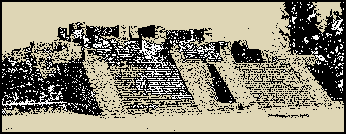
Teopanzolco
LOCATION:
Teopanzolco is located in the city of Cuernavaca, just northeast of the
railroad station. The site is an official archaeological zone
maintained by the Instituto Nacional de Antropología e Historia.
There is a modest admission fee Tuesday-Saturday; admission is free
Sundays and the zone is closed Mondays.
DESCRIPTION OF RUINS:
The present archaeological zone consists of a public plaza surrounded
by various structures, including a large pyramid, numerous low
platforms, and other structures. The architecture dates to the Early
Aztec period (as determined by the ceramics). The pyramid is one of the
few surviving examples of the Aztec twin-stair pyramid style popular in
the Early Aztec period, AD 1100-1350 (the Mexica Templo Mayor of
Tenochtitlan, located in modern Mexico City, was a Late Aztec structure
built in the earlier style). Across the plaza from the pyramid is a row
of low stone platforms that were bases for altars. Excavations in one
of these turned up a mass sacrificial burial consisting of skulls from
decapitated individuals and offerings of pottery vessels and other
items. There are several partially-excavated buildings in the zone
whose functions are uncertain.
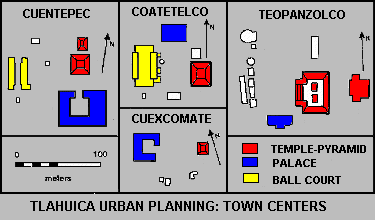 Teopanzolco was an Early Aztec site that was apparently abandoned
during the Late Aztec period (AD 1350-1521). This judgment is based
upon my study of ceramics excavated in various structures at the zone.
These ceramics form the basis for the definition of the "Teopanzolco
Ceramic Complex."
Teopanzolco was an Early Aztec site that was apparently abandoned
during the Late Aztec period (AD 1350-1521). This judgment is based
upon my study of ceramics excavated in various structures at the zone.
These ceramics form the basis for the definition of the "Teopanzolco
Ceramic Complex."
ARCHAEOLOGICAL FIELDWORK:
According to local legend, the Teopanzolco pyramid was discovered
during the Mexican Revolution of 1910 when the Zapatista troops were
bombarding downtown Cuernavaca. Cannons were placed on top of a large
mound, an ideal location overlooking downtown. The vibrations of the
cannons caused the dirt to move, exposing the stone walls of the
temples on top of the pyramid. After the revolution, archaeologist
Alfonso Caso excavated the pyramid and restored the architecture. The
restoration is interesting, because two stages of construction were
left visible to the public. Mesoamerican pyramids were constructed in
numerous stages, but most reconstructions leave only the final stage
visible.
Various other Mexican archaeologists have excavated at Teopanzolco over
the years, including Eduardo Noguera and Román Piña
Chán, Roberto Gallegos, and Jorge Angulo. I analyzed ceramics
from Jorge Angulo’s excavations. Ceramic vessels from the sacrificial
burial are on display in the Palacio de Cortés Museum in
Cuernavaca (although they are not identified as such in the exhibit).
IMPORTANCE:
The site of Teopanzolco is important for several reasons. The pyramid
is one of the best examples of the Early Aztec twin-stair pyramid type,
and shows the model that the Mexica imitated when building their Templo
Mayor. The sacrificial burial provides dramatic evidence for human
sacrifice among the Tlahuica in Early Aztec times. This shows that
human sacrifice was practiced by Aztec groups other than the Mexica,
and it provides time depth for the practice in Morelos. The burial
exposes as a lie the statement Tlahuica informants made to Spaniards in
1570 that their ancestors did not carry out human sacrifices until they
were forced to after being conquered by the Mexica. The archaeological
record thus provides a correction to the biases of the written record.
In my view, Teopanzolco was the center of the original city of
Cuauhnahuac, founded by the Tlahuica in the Early Aztec period. The
size and grandeur of the pyramid and plaza are befitting a major Aztec
city. For some unknown reason, the center of the city was then moved in
Late Aztec times to what is now the center of Cuernavaca. We have no
idea why the Teopanzolco zone was abandoned in the Late Aztec period.


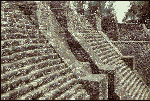
You can click on these photos of buildings at Teopanzolco.
REFERENCES ON TEOPANZOLCO:
Angulo Villaseñor, Jorge
1976 Teopanzolco y Cuauhnahuac, Morelos. In Los Señoríos
e Estados Militaristas, edited by Román Piña Chán,
pp. 183-208. Instituto Nacional de Antropología e Historia,
Mexico City.
Lagunas, Zaid and Carlos Serrano Sánchez
1972 Decapitación y desmembramiento corporal dn Teopanzolco,
Morelos. In Religión en Mesoamérica. XII Mesa Redonda.,
edited by and Neomí Castillo Tejero Jaime Litvak King, pp.
429-34. Sociedad Mexicana de Antropología, Mexico City.
Marquina, Ignacio
1964 Arquitectura Prehispánica. Instituto Nacional de
Antropología e Historia, Mexico City.
Noguera, Eduardo and Román Piña Chán
1956 Estratigrafía de Teopanzolco. In Revista Mexicana de
Estudios Antropológicos 14:139-156.
Ordoñez, Ezequiel
1938 Las ruinas de Teopanzolco en Cuernavaca, Morelos. Revista Mexicana
de Ingeniera y Arquitectura 16:609-622..
Smith, Michael E.
n.d. Tlahuica Ceramics: The Aztec-Period Ceramics of Morelos, Mexico,
Monograph in preparation.
To Return to the Site List: Click Here
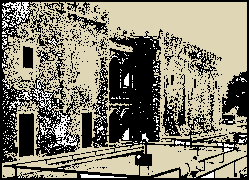
Palacio de Cortés Site
LOCATION:
The Palacio de Cortés site is located under the Palacio de
Cortés on the zocalo in downtown Cuernavaca. The Palacio is a
sixteenth-century Spanish building that now houses the major
anthropology museum of Cuernavaca. Ruins of the Tlahuica structures can
be seen in front of the Palacio and in several open patios of the
museum.
DESCRIPTION OF FIELDWORK AND RUINS:
After the conquest of Mexico, Hernando Cortés built a large
residence (the "Palacio de Cortés") in the middle of the new
Spanish-Tlahuica city of Cuernavaca (renamed from Cuauhnahuac by the
Spaniards, who evidently could not pronounce the Aztec name). He
constructed the building over the ruins of the former palace of the
king of Cuauhnahuac. Cuauhnahuac had been a powerful Aztec city-state,
and the royal palace was probably quite extensive and luxurious. The
Cortés palace served as a residence and then a civic building
over the centuries.
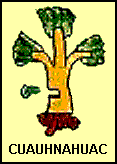 In the early 1970’s the structure was renovated to turn it into a
museum. In the process of this work, excavations were carried out into
the Tlahuica and Spanish Colonial remains around and under the
building. This fieldwork, directed by archaeologist Jorge Angulo
Villaseñor, led to the exposure of various walls, floors,
burials, and other features from the Tlahuica and Colonial periods.
These were preserved where possible, mainly in front of the building
and in several open patios inside. Later excavations by Wanda Tommasi
de Magrelli in the Cuernavaca zocalo in front of the Palacio turned up
remains related to the Palacio site.
In the early 1970’s the structure was renovated to turn it into a
museum. In the process of this work, excavations were carried out into
the Tlahuica and Spanish Colonial remains around and under the
building. This fieldwork, directed by archaeologist Jorge Angulo
Villaseñor, led to the exposure of various walls, floors,
burials, and other features from the Tlahuica and Colonial periods.
These were preserved where possible, mainly in front of the building
and in several open patios inside. Later excavations by Wanda Tommasi
de Magrelli in the Cuernavaca zocalo in front of the Palacio turned up
remains related to the Palacio site.
IMPORTANCE:
The Palacio de Cortés site is one of the only Aztec royal
palaces to be excavated by archaeologists. Unfortunately, little
architecture was left after the building was destroyed by Cortés
(a far-better preserved royal palace is being excavated at the site of
Yautepec – see below). The ruins exposed today under the front steps of
the museum provide one of the most graphic examples of the Spanish
practice of constructing major buildings on top of the ruins of
important Aztec structures. This practice, more commonly involving
churches built on top of the rubble of pyramid-temples, was an
ideological statement of Spanish control in their new colonies.
To archaeologists, Jorge Angulo’s excavations are important for the
artifacts that were recovered. Test pits encountered stratigraphic
evidence for the sequence of Early Aztec (Teopanzolco phase) deposits
underneath Late Aztec (Tecpan phase) deposits, both sealed by Spanish
Colonial deposits. I relied on artifacts from these deposits to
establish the Tlahuica chronology of Cuernavaca. Thomas Charlton,
Cynthia Otis Charlton, and Patricia Fournier studied the early Spanish
colonial artifacts from the Palacio excavations.


REFERENCES ON THE PALACIO DE CORTES SITE:
Angulo Villaseñor, Jorge
1976 Teopanzolco y Cuauhnahuac, Morelos. In Los Señoríos
e Estados Militaristas, edited by Román Piña Chán,
pp. 183-208. Instituto Nacional de Antropología e Historia,
Mexico City.
Angulo Villaseñor, Jorge
1979 Una Visión del Museo Cuauhnahuac en el Palacio de
Cortés: Recopoliación
Histórico-Arqueológico del Proceso de Cambio en el Estado
de Morelos. Instituto Nacional de Antropología e Historia,
Mexico City.
Smith, Michael E.
n.d. Tlahuica Ceramics: The Aztec-Period Ceramics of Morelos, Mexico,
Monograph in preparation.
To Return to the Site List: Click Here
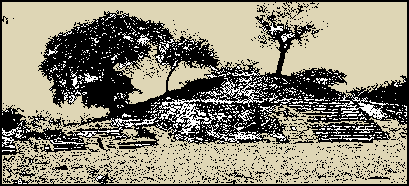
Coatetelco
LOCATION:
The Coatetelco site is located in the modern town of the same name in
western Morelos. The town can be reached by the highway that goes by
the ruins of Xochicalco; the well-marked turn-off is in Mazatepec
several miles beyond Xochicalco. The site is several blocks up the road
from the main church in Coatetelco. The site is an official I.N.A.H.
archaeological zone, open daily except Monday.
DESCRIPTION OF RUINS:
Coatetelco was a medium-sized urban site in the Late Aztec period. The
central part of the city has been excavated and restored, including a
ball-court, a small temple-pyramid, and several other structures, all
grouped around a public plaza. There is a small museum with finds from
the site. The ball-court is an especially nice example of a small
Mesoamerican ball-court. Excavations under the main stairway of the
flanking platform encountered elite burials with hundreds of grave
goods, including ceramic vessels, obsidian, jade, and copper-bronze
objects. An unusual carefully-stacked pile of manos (basalt tools for
grinding maize on a metate) was found adjacent to the ball-court; this
is still visible today.
ARCHAEOLOGICAL FIELDWORK:
Coatetelco was excavated in the 1970s by archaeologist Raúl
Arana, who oversaw reconstruction of most of the architecture. Several
minor excavations have been done since that time to keep the site in
good condition. Ceramics from Arana’s excavations are described in my
current monograph.
IMPORTANCE:
Coatetelco is important because it is one of the only small or
medium-sized Aztec cities whose central precinct has been completely
excavated. The ball-court is one of the few surviving from Aztec times,
and the modest temple-pyramid shows that not all Aztec cities had large
imposing pyramids as at Tenochtitlan or Teopanzolco. The museum has a
good display of Tlahuica artifacts, including some impressive
long-handle incense burners from the burials at the ball-court.



REFERENCES ON COATETELCO:
Angulo Villaseñor, Jorge
1978 El Museo de Cuauhtetelco: Guia Oficial. Instituto Nacional de
Antropología e Historia, Mexico City.
Arana, Raul
1976 Trabajos Efectuados en Coatetelco. Unpublishd Report submitted to
the Centro Regional Morelos, Instituto Nacional de Antropología
e Historia.
<
Smith, Michael E.
n.d. Tlahuica Ceramics: The Aztec-Period Ceramics of Morelos, Mexico,
Monograph in preparation.
To Return to the Site List: Click Here
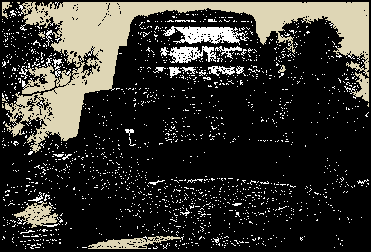
Tepozteco
LOCATION:
The Tepozteco site sits on top of cliffs overlooking the modern town of
Tepoztlan. Tepoztlan can be reached by car or bus from Cuernavaca. To
reach the site, visitors must climb a trail that leads off the end of
the main street (the climb takes over an hour). As an official INAH
archaeological zone, the site is open daily except Mondays.
DESCRIPTION OF RUINS:
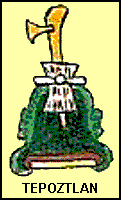 The major feature at the Tepozteco site is the Temple of Tepozteco, an
Aztec/Tlahuica god. This is a small temple on a platform noteworthy for
its carved inscriptions depicting various religious themes. As
interpreted by Eduard Seler, and H.B. Nicholson, these carvings depict
offerings and sacrifices related to the gods of pulque (an alcoholic
drink used by the Aztecs). A stone panel with the name glyph of the
Mexica king Ahuitzotl was recovered at this temple, and is now on
display at the National Museum of Anthropology in Mexico City. Many
authors attribute construction of the temple to Ahuitzotl based on the
carving, but in fact the temple was probably built in Early Aztec times
(AD 1100-1350), long before Ahuitzotl was born. The Mexica king
probably sponsored a rebuilding or rededication of the structure.
The major feature at the Tepozteco site is the Temple of Tepozteco, an
Aztec/Tlahuica god. This is a small temple on a platform noteworthy for
its carved inscriptions depicting various religious themes. As
interpreted by Eduard Seler, and H.B. Nicholson, these carvings depict
offerings and sacrifices related to the gods of pulque (an alcoholic
drink used by the Aztecs). A stone panel with the name glyph of the
Mexica king Ahuitzotl was recovered at this temple, and is now on
display at the National Museum of Anthropology in Mexico City. Many
authors attribute construction of the temple to Ahuitzotl based on the
carving, but in fact the temple was probably built in Early Aztec times
(AD 1100-1350), long before Ahuitzotl was born. The Mexica king
probably sponsored a rebuilding or rededication of the structure.
Near the Tepozteco temple are a series of residential terraces with
remains of Early Aztec-period occupation. This may have been a living
area for priests or caretakers of the temple. The terraces are
immediately above the steep cliffs, and have an excellent view of the
town and valley of Tepoztlan.
ARCHAEOLOGICAL FIELDWORK:
Little fieldwork has been done at the Tepozteco temple beyond periodic
work directed at maintenance of the architecture. Jorge Angulo
Villaseñor dug several test pits near the temple and also
recovered artifacts from the construction fill. I analyzed ceramics
from his excavations, and used these to define the "Tepozteco Ceramic
Complex," an Early Aztec artifact assemblage. Giselle Canto, Hortensia
de Vega Nova and Ana Maria Pelz of the Centro INAH en Morelos also
excavated test pits near the temple in the early 1990s.
There has been little archaeological fieldwork in the modern town of
Tepoztlan below the cliffs. Tepoztlan was an independent city-state in
Aztec times, and the Aztec town probably lies under the modern town
center. Various small Aztec-period structures have been located in the
modern town. There is a good example of a sixteenth-century church and
convent in Tepoztlan (now run by INAH and open to the public), and test
excavations by Canto, de Vega, and Pelz uncovered Aztec-period deposits
in the churchyard.
IMPORTANCE:
The Tepozteco temple is important for the pulque iconography, and for
its location with a spectacular view of the region. The ceramics from
the test pits and terraces are important for the definition of the
Early Aztec Tepozteco Ceramic Complex.
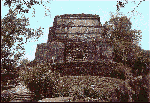

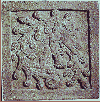

REFERENCES ON TEPOZTECO:
de Vega Nova, Hortensia
1993 Informe Parcial del Proyecto Excavaciones Estratigráficas
en Morelos. Unpublished report submitted to the Instituto Nacional de
Antropología e Historia, Cuernavaca, Morelos.
Marquina, Ignacio
1964 Arquitectura Prehispánica. Instituto Nacional de
Antropología e Historia, Mexico City.
Nicholson, H.B.
1991 The Octli Cult in Late Pre-Hispanic Central Mexico. In: To Change
Place: Aztec Ceremonial Landscapes, edited by Davíd Carrasco,
pp. 158-187. University Press of Colorado, Niwot.
Seler, Eduard
1904 Temple pyramid of Tepoxtlan. In Mexican and Central American
Antiquities, Calendar Systems, and History, edited by Charles P.
Bowditch, pp. 341-52. Smithsonian Institution, Bureau of American
Ethnology, Bulletin, no. 28, Washington, DC.
Smith, Michael E.
n.d. Tlahuica Ceramics: The Aztec-Period Ceramics of Morelos, Mexico,
Monograph in preparation.
To Return to the Site List: Click Here
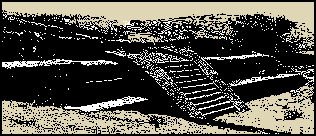
Yautepec
LOCATION:
The site of Yautepec lies under the modern town of the same name,
located on the free highway between Cuernavaca and Cuautla. The major
ruin open to the public is a Tlahuica palace in the Barrio Rancho
Nuevo, on the road into town from the south. The palace is close to the
cemetery; the entrance is on a street parallel to the main road. The
palace is an INAH archaeological zone, open most days.
DESCRIPTION OF RUINS:
The Yautepec palace is the only Aztec royal palace to be extensively
excavated by archaeologists. It is a large mound (nearly 7,000 square
meters, or 1.3 acres) at the edge of modern Yautepec, only part of
which has been uncovered. The structure was a platform several meters
high entered by a single stairway on the west side. On top of the
platform are a series of rooms, courtyards, and passageways built of
stone with lime plaster coverings. The walls were originally covered
with elaborate polychrome murals, only fragments of which have
survived.
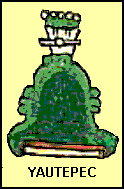 Several blocks from the pyramid is an Aztec-period elite residential
structure on the grounds of the public secondary school. The outer
walls have been destroyed, but much of the interior was intact when
excavated in 1993. Other Tlahuica houses and deposits excavated in 1993
were reburied and are not open for viewing today.
Several blocks from the pyramid is an Aztec-period elite residential
structure on the grounds of the public secondary school. The outer
walls have been destroyed, but much of the interior was intact when
excavated in 1993. Other Tlahuica houses and deposits excavated in 1993
were reburied and are not open for viewing today.
ARCHAEOLOGICAL FIELDWORK:
The Yautepec palace is the subject of a long-term excavation under the
direction of Hortensia de Vega Nova of the Centro INAH en Morelos.
Fieldwork began in 1989 when the structure, a large mound, was
threatened by the subdivision of a large parcel of land. In several
seasons since that time, the western facade and steps have been
excavated and restored, and about one-fourth of the top area has been
cleared. The materials from these excavations are still being analyzed;
some of the ceramics are on display at the Seguro Social community
center in Yautepec.
In 1992 and 1993, archaeologists from the University at Albany under my
direction surveyed the city of Yautepec and excavated Tlahuica houses
and deposits in fourteen areas (see map below). The only excavation
from this project that is open to the public is the elite residence in
the school yard mentioned above.
For more information about the Albany project at Yautepec: Click Here
IMPORTANCE:
As the only Aztec royal palace to be extensively excavated, the
Yautepec structure provides unique information on Aztec palaces. Royal
palaces from Tenochtitlan and other cities in the Valley of Mexico were
all destroyed or else their locations are unknown to archaeologists,
and only small portions of the Cuauhnahuac royal palace in Cuernavaca
survive today (see the Palacio de Cortés site above).


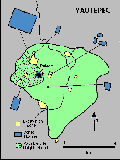
REFERENCES ON THE YAUTEPEC PALACE:
de Vega Nova, Hortensia and Pablo Mayer Guala
1990 Proyecto Yautepec, Morelos. Boletín del Consejo de
Arqueología 1990: 94-101.
de Vega Nova, Hortensia and Pablo Mayer Guala
1991 Proyecto Yautepec. Boletín del Consejo de
Arqueología 1991:79-84.
Smith, Michael E.
1996 The Aztecs. Blackwell Publishers, Oxford.
Smith, Michael E., Cynthia Heath-Smith, Ronald Kohler, Joan Odess,
Sharon Spanogle and Timothy Sullivan
1994 The Size of the Aztec city of Yautepec: Urban Survey in Central
Mexico. Ancient Mesoamerica 5:1-11.
To Return to the Site List: Click Here
OTHER TLAHUICA SITES:
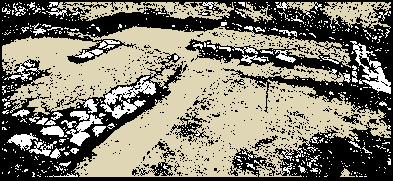 Many of
the modern towns in Morelos are built over the ruins of Tlahuica cities
and towns. Modern construction activities frequently turn up Tlahuica
(and earlier) buildings, burials, and other deposits, and these finds
are monitored by the Centro INAH en Morelos (Instituto Nacional de
Antropología e Historia). A number of smaller Tlahuica sites
have been surveyed or excavated by archaeologists, but few of these are
open to the public (their remains are not very spectacular, and in many
cases the architecture has not been judged worthy of restoration).
Many of
the modern towns in Morelos are built over the ruins of Tlahuica cities
and towns. Modern construction activities frequently turn up Tlahuica
(and earlier) buildings, burials, and other deposits, and these finds
are monitored by the Centro INAH en Morelos (Instituto Nacional de
Antropología e Historia). A number of smaller Tlahuica sites
have been surveyed or excavated by archaeologists, but few of these are
open to the public (their remains are not very spectacular, and in many
cases the architecture has not been judged worthy of restoration).
For information about the rural Tlahuica sites of Cuexcomate and
Capilco: Click Here
 Other Tlahuica sites with some fieldwork include Coatlan Viejo (a small
city-state center surveyed by Roger Mason), Cuentepec (a city-state
center surveyed by Osvaldo Sterpone), Zacatepechi (a small site
excavated by Jaime Litvak King and Donovan Senter), Huaxtepec and
Tepoztlan (two city-state capitals tested by Hortensia de Vega Nova,
Giselle Canto and Ana Maria Pelz), and Tetla (an Early Aztec residence
excavated by David Grove). Also, excavations at many pre-Tlahuica
turned up evidence of Tlahuica occupations after the main occupations
of the sites. These sites include Xochicalco, Chalcatzingo, Las Pilas,
and Olintepec.
Other Tlahuica sites with some fieldwork include Coatlan Viejo (a small
city-state center surveyed by Roger Mason), Cuentepec (a city-state
center surveyed by Osvaldo Sterpone), Zacatepechi (a small site
excavated by Jaime Litvak King and Donovan Senter), Huaxtepec and
Tepoztlan (two city-state capitals tested by Hortensia de Vega Nova,
Giselle Canto and Ana Maria Pelz), and Tetla (an Early Aztec residence
excavated by David Grove). Also, excavations at many pre-Tlahuica
turned up evidence of Tlahuica occupations after the main occupations
of the sites. These sites include Xochicalco, Chalcatzingo, Las Pilas,
and Olintepec.
References:
Angulo Villaseñor, Jorge
1976 Teopanzolco y Cuauhnahuac, Morelos. In Los Señoríos
e Estados Militaristas, edited by Román Piña Chán,
pp. 183-208. Instituto Nacional de Antropología e Historia,
Mexico City.
Angulo Villaseñor., Jorge and Raúl M. Arana A.
1988 La Cerámica de los Tlahuica. In Ensayos de Alfarería
Prehispánica e Histórica de Mesoamérica: Homenaje
a Eduardo Noguera Auza, edited by Mari Carmen Serra Puche and Carlos
Navarrete Cáceres, pp. 343-385. Universidad Nacional
Autónoma de México, Mexico City.
de Vega Nova, Hortensia
1993 Informe Parcial del Proyecto Excavaciones Estratigráficas
en Morelos. Unpublished report submitted to the Instituto Nacional de
Antropología e Historia, Cuernavaca, Morelos.
Litvak King, Jaime
1970 El Valle de Xochicalco: Formación y Análisis de un
Modelo Estadístico. PhD dissertation,, Universidad Nacional
Autónoma de México.
Mason, Roger D.
1980 Economic and Social Organization of an Aztec Provincial Center:
Archaeological Research at Coatlan Viejo, Morelos, Mexico. PhD
dissertation, Department of Anthropology, University of Texas.
Norr, Lynette
1987 The Excavation of a Postclassic House at Tetla. In Ancient
Chalcatzingo, edited by David C. Grove, pp. 400-408. University of
Texas Press, Austin.
Senter, Donovan C.
1980 Un estudio de la distribución de los tipos cerámicos
del sitio de Zacatepechi, Morelos. Anales de Antropología
16:105-122.
Smith, Michael E.
1983 Postclassic Culture Change in Western Morelos, Mexico: The
Development and Correlation of Archaeological and Ethnohistorical
Chronologies. PhD dissertation, Department of Anthropology, University
of Illinois.
Smith, Michael E.
1992 Archaeological Research at Aztec-Period Rural Sites in Morelos,
Mexico. Volume 1, Excavations and Architecture / Investigaciones
Arqueológicas en Sitios Rurales de la Epoca Azteca en Morelos,
Tomo 1: Excavaciones y Arquitectura. University of Pittsburgh Memoirs
in Latin American Archaeology 4. University of Pittsburgh, Pittsburgh.
(bilingual site report).
.....For a description of this book: Click
Here.
Smith, Michael E.
1996 The Aztecs. Blackwell Publishers, Oxford.
.....For a description of this book: Click Here.
Smith, Michael E.
n.d. Tlahuica Ceramics: The Aztec-Period Ceramics of Morelos, Mexico,
Monograph in preparation.
Smith, Michael E. and Kenneth G. Hirth
1988 The Development of Prehispanic Cotton-spinning Technology in
Western Morelos, Mexico. Journal of Field Archaeology 15:349-358
To Return to the Site List: Click Here
Pre-Tlahuica Ruins in Morelos:
The two best-known archaeological sites in Morelos pre-date the
Tlahuica culture. Xochicalco in the western portion of the state is an
impressive hilltop urban center dating primarily to the Epiclassic
period (AD 700-900). The site has been the setting of major fieldwork
projects by Kenneth G. Hirth (Pennsylvania State University) and
Norberto González Crespo and Silvia Garza de González
(Centro INAH en Morelos).
Chalcatzingo in southeastern Morelos was an important chiefdom center
in the Middle Formative period (AD 1200-600). It is well known for the
numerous "Olmec-style" rock carvings. Major excavations by David C.
Grove (University of Illinois) provided important information on this
site.
Information about Xochicalco, Chalcatzingo, and other archaeological
sites in Morelos can be found at the: State of
Morelos Tourism Web Page.
References:
Grove, David C.
1987 Ancient Chalcatzingo. University of Texas Press, Austin.
Hirth, Kenneth G.
1995 Urbanism, Militarism, and Architectural Design: An Analysis of
Epiclassic Sociopoltical Structure at Xochicalco. Ancient Mesoamerica
6:237-250.
Hirth, Kenneth G. and Ann Cyphers Guillén
1988 Tiempo y asentamiento en Xochicalco. Universidad Nacional
Autónoma de México, Mexico City.
RETURN TO THE TOP OF THE DOCUMENT
 For More Information:
For More Information:
Tlahuica Peoples of Morelos || Tlahuica Culture Home Page ||
Tlahuica Peasant Sites || Excavations at Yautepec ||
Michael E. Smith's Home Page || Description of the book, THE AZTECS ||
Institute for
Mesoamerican Studies home page ||
© 2003, Michael E. Smith (updated 10/30/03)
 By Dr. Michael E. Smith,
Professor of Anthropology, University at Albany (State University of
New York)
By Dr. Michael E. Smith,
Professor of Anthropology, University at Albany (State University of
New York)
 Aztec culture was composed of many distinct ethnic groups that occupied
the central Mexican highlands in the centuries before the Spanish
conquest of 1521. The Tlahuica were the Aztec group living in what is
now the state of Morelos. Archaeologically, the Tlahuica culture dates
to the final centuries before the arrival of Spanish conquerors in
1521. The Tlahuica peoples migrated into Morelos in the Early Aztec
period (AD 1100-1350), also known as the Middle Postclassic period in
Mesoamerica. The Tlahuica expanded their numbers and influence in the
Late Aztec period (AD 1350-1521), also known as the Late Postclassic
period. Because Tlahuica culture was one variant of the more inclusive
Aztec culture of central Mexico, some Tlahuica traits and practices
were shared by all the Aztec peoples and some were unique. Readers are
encouraged to consult the publications listed under each site for
additional information.
Aztec culture was composed of many distinct ethnic groups that occupied
the central Mexican highlands in the centuries before the Spanish
conquest of 1521. The Tlahuica were the Aztec group living in what is
now the state of Morelos. Archaeologically, the Tlahuica culture dates
to the final centuries before the arrival of Spanish conquerors in
1521. The Tlahuica peoples migrated into Morelos in the Early Aztec
period (AD 1100-1350), also known as the Middle Postclassic period in
Mesoamerica. The Tlahuica expanded their numbers and influence in the
Late Aztec period (AD 1350-1521), also known as the Late Postclassic
period. Because Tlahuica culture was one variant of the more inclusive
Aztec culture of central Mexico, some Tlahuica traits and practices
were shared by all the Aztec peoples and some were unique. Readers are
encouraged to consult the publications listed under each site for
additional information.

 Teopanzolco was an Early Aztec site that was apparently abandoned
during the Late Aztec period (AD 1350-1521). This judgment is based
upon my study of ceramics excavated in various structures at the zone.
These ceramics form the basis for the definition of the "Teopanzolco
Ceramic Complex."
Teopanzolco was an Early Aztec site that was apparently abandoned
during the Late Aztec period (AD 1350-1521). This judgment is based
upon my study of ceramics excavated in various structures at the zone.
These ceramics form the basis for the definition of the "Teopanzolco
Ceramic Complex."




 In the early 1970’s the structure was renovated to turn it into a
museum. In the process of this work, excavations were carried out into
the Tlahuica and Spanish Colonial remains around and under the
building. This fieldwork, directed by archaeologist Jorge Angulo
Villaseñor, led to the exposure of various walls, floors,
burials, and other features from the Tlahuica and Colonial periods.
These were preserved where possible, mainly in front of the building
and in several open patios inside. Later excavations by Wanda Tommasi
de Magrelli in the Cuernavaca zocalo in front of the Palacio turned up
remains related to the Palacio site.
In the early 1970’s the structure was renovated to turn it into a
museum. In the process of this work, excavations were carried out into
the Tlahuica and Spanish Colonial remains around and under the
building. This fieldwork, directed by archaeologist Jorge Angulo
Villaseñor, led to the exposure of various walls, floors,
burials, and other features from the Tlahuica and Colonial periods.
These were preserved where possible, mainly in front of the building
and in several open patios inside. Later excavations by Wanda Tommasi
de Magrelli in the Cuernavaca zocalo in front of the Palacio turned up
remains related to the Palacio site.







 The major feature at the Tepozteco site is the Temple of Tepozteco, an
Aztec/Tlahuica god. This is a small temple on a platform noteworthy for
its carved inscriptions depicting various religious themes. As
interpreted by Eduard Seler, and H.B. Nicholson, these carvings depict
offerings and sacrifices related to the gods of pulque (an alcoholic
drink used by the Aztecs). A stone panel with the name glyph of the
Mexica king Ahuitzotl was recovered at this temple, and is now on
display at the National Museum of Anthropology in Mexico City. Many
authors attribute construction of the temple to Ahuitzotl based on the
carving, but in fact the temple was probably built in Early Aztec times
(AD 1100-1350), long before Ahuitzotl was born. The Mexica king
probably sponsored a rebuilding or rededication of the structure.
The major feature at the Tepozteco site is the Temple of Tepozteco, an
Aztec/Tlahuica god. This is a small temple on a platform noteworthy for
its carved inscriptions depicting various religious themes. As
interpreted by Eduard Seler, and H.B. Nicholson, these carvings depict
offerings and sacrifices related to the gods of pulque (an alcoholic
drink used by the Aztecs). A stone panel with the name glyph of the
Mexica king Ahuitzotl was recovered at this temple, and is now on
display at the National Museum of Anthropology in Mexico City. Many
authors attribute construction of the temple to Ahuitzotl based on the
carving, but in fact the temple was probably built in Early Aztec times
(AD 1100-1350), long before Ahuitzotl was born. The Mexica king
probably sponsored a rebuilding or rededication of the structure.





 Several blocks from the pyramid is an Aztec-period elite residential
structure on the grounds of the public secondary school. The outer
walls have been destroyed, but much of the interior was intact when
excavated in 1993. Other Tlahuica houses and deposits excavated in 1993
were reburied and are not open for viewing today.
Several blocks from the pyramid is an Aztec-period elite residential
structure on the grounds of the public secondary school. The outer
walls have been destroyed, but much of the interior was intact when
excavated in 1993. Other Tlahuica houses and deposits excavated in 1993
were reburied and are not open for viewing today.



 Many of
the modern towns in Morelos are built over the ruins of Tlahuica cities
and towns. Modern construction activities frequently turn up Tlahuica
(and earlier) buildings, burials, and other deposits, and these finds
are monitored by the Centro INAH en Morelos (Instituto Nacional de
Antropología e Historia). A number of smaller Tlahuica sites
have been surveyed or excavated by archaeologists, but few of these are
open to the public (their remains are not very spectacular, and in many
cases the architecture has not been judged worthy of restoration).
Many of
the modern towns in Morelos are built over the ruins of Tlahuica cities
and towns. Modern construction activities frequently turn up Tlahuica
(and earlier) buildings, burials, and other deposits, and these finds
are monitored by the Centro INAH en Morelos (Instituto Nacional de
Antropología e Historia). A number of smaller Tlahuica sites
have been surveyed or excavated by archaeologists, but few of these are
open to the public (their remains are not very spectacular, and in many
cases the architecture has not been judged worthy of restoration).
 Other Tlahuica sites with some fieldwork include Coatlan Viejo (a small
city-state center surveyed by Roger Mason), Cuentepec (a city-state
center surveyed by Osvaldo Sterpone), Zacatepechi (a small site
excavated by Jaime Litvak King and Donovan Senter), Huaxtepec and
Tepoztlan (two city-state capitals tested by Hortensia de Vega Nova,
Giselle Canto and Ana Maria Pelz), and Tetla (an Early Aztec residence
excavated by David Grove). Also, excavations at many pre-Tlahuica
turned up evidence of Tlahuica occupations after the main occupations
of the sites. These sites include Xochicalco, Chalcatzingo, Las Pilas,
and Olintepec.
Other Tlahuica sites with some fieldwork include Coatlan Viejo (a small
city-state center surveyed by Roger Mason), Cuentepec (a city-state
center surveyed by Osvaldo Sterpone), Zacatepechi (a small site
excavated by Jaime Litvak King and Donovan Senter), Huaxtepec and
Tepoztlan (two city-state capitals tested by Hortensia de Vega Nova,
Giselle Canto and Ana Maria Pelz), and Tetla (an Early Aztec residence
excavated by David Grove). Also, excavations at many pre-Tlahuica
turned up evidence of Tlahuica occupations after the main occupations
of the sites. These sites include Xochicalco, Chalcatzingo, Las Pilas,
and Olintepec.
 For More Information:
For More Information: